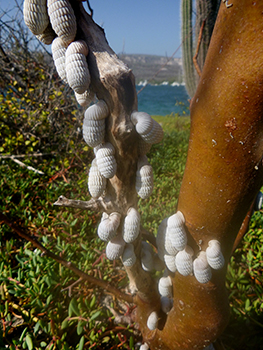This post is also available in: Dutch (below)
Anyone who walks in the mondi of Jan Thiel on Curaçao during the dry season, and other locations as well, can regularly come across a strange phenomenon; trees, grasses and shrubs that are completely covered with the white Kokolishi di kalakuna (Cerion uva). It looks as if the shells have advanced like an army column, only to come to a standstill from one moment to the next. This endemic snail species for Curaçao is an animal that takes years to grow as large as the shells you see around in the wild. The reason for this is the fact that the animals are only active during a wet period and are in sort of a dry sleep the rest of the time.

When it starts to rain and the rainwater flows over the branches and stems of trees and shrubs, the types of algae and mosses that live on the bark of these plants are activated. This is the most important food for the snails. They then come to life and scrape along the stems and branches with their mouth parts to collect their food. Because the snails are very sensitive to heat and dryness, they do this mainly when it is not so warm outside in early mornings, late afternoons and also at night. Slowly but surely, large groups of Cerion uva move along the stems and twigs to eat. When it gets too hot, they close the opening of the shell with mucus that hardens into a plastic-like membrane and remain still in their place until it is possible to eat or reproduce safely again. In this way, they can survive in the drought for years. If the rain is short-lived, you will find them en masse stuck to plants and bushes while walking. As if turned to stone, but still alive.
English name: Cerion uva
Papiamentu name: Kokolishi di kalakuna
Scientific name: Cerion uva
Family: Cerionidae
Occurrence (ABC islands): Endemic on Curaçao, Bonaire, Klein Bonaire

Struiken en stammen vol schelpen
Wie in de droge tijd wandelt in de mondi van bijvoorbeeld Jan Thiel kan regelmatig een vreemd fenomeen tegenkomen; boompjes, grassen en struiken die helemaal bedekt zitten met de witte Kokolishi di kalakuna (Cerion uva). Het lijkt alsof de schelpen als een legercolonne voortgeschreden zijn om van het een op het ander moment stil te vallen. Deze endemische slakkensoort voor Curaçao is dier dat er jaren over doet om zo groot te worden als je ze ziet. En dat komt omdat de dieren alleen in een natte periode actief zijn en de rest van de tijd in een droogteslaap zitten.

Als het gaat regenen en het water over de takken en stengels van bomen en struiken stroomt worden de op de bast van deze planten levende soorten algen en mossen geactiveerd. Dit is het belangrijkste voedsel voor de slakken die dan ook tot leven komen en met hun monddelen langs de stengels en takken schrapen om hun voedsel te verzamelen. Omdat de slakken zeer gevoelig zijn voor warmte en droogte doen ze dat voornamelijk wanneer het nog niet zo warm is in de buitenlucht. Langzaam maar zeker bewegen grote groepen Cerion uva zich langs de stengels en takjes om te eten. Wordt het te warm dan sluiten ze de opening van de schelp af met mucus dat verhard tot een plasticachtig vlies en blijven stil op hun plek zitten tot het weer mogelijk is om veilig te eten of voort te planten. Zo kunnen ze jarenlang overleven in de droogte. Is de regen van korte duur dan vind je ze massaal vastgeplakt op planten en struiken tijdens het wandelen. Als versteend, maar nog steeds levend.
Nederlandse naam: –
Papiamentse naam: Kokolishi di kalakuna
Wetenschappelijke naam: Cerion uva
Family: Cerionidae (Peanut shells)
Voorkomen (ABC eilanden): Endemisch voor Curaçao, Bonaire en Klein Bonaire